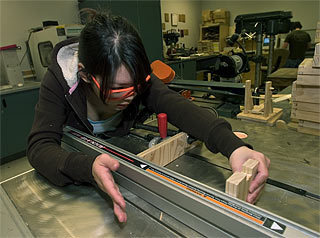New California vocational education standards/programs: a best practices approach
 Vanna Lee sets up a table saw as she makes a jewelry box for her class in manufacturing technology at Laguna Creek High School. Lee, a senior, is planning to move on to college and study engineering. If adopted, new standards in the state's career classes would combine math, science and English in a way that helps students gain the skills employers demand. Sacramento Bee/Jay Mather.
Vanna Lee sets up a table saw as she makes a jewelry box for her class in manufacturing technology at Laguna Creek High School. Lee, a senior, is planning to move on to college and study engineering. If adopted, new standards in the state's career classes would combine math, science and English in a way that helps students gain the skills employers demand. Sacramento Bee/Jay Mather.Something we don't think about much is how vocational education--and the California programs discussed in "Hands-on education: The state's policymaking board is voting today on how schools can teach vocational skills while reinforcing math, science and other academic standards," from the Sacramento Bee more directly intertwine vocational and academic learning--undergirds entrepreneurialism and the development of independent businesses. Most big businesses start as small businesses. And most big businesses don't move to communities (sure, manufacturing plants such as a Toyota plant in the south are exceptions) but grow within regions.
From the article:
The board's vote on about 500 pages of documents that detail how schools should teach skills related to 15 growing industries will mark more than an administrative hurdle, educators say. It will establish, for the first time in California's schools, a systematic approach to teaching occupations -- the kind students can enter right out of high school as well as those that will require more training in college.
Previously, when it came to vocational training in the state's public schools, "there were no strategies or suggestions or ways to implement what you wanted to teach," said Jack O'Connell, the state superintendent.
Also see "Training the new work force," about manufacturing technology training programs in western Massachusetts, from the Berkshire Eagle. That area is one of the birthplaces of the U.S. plastics industry.
Index Keywords: education



0 Comments:
Post a Comment
<< Home